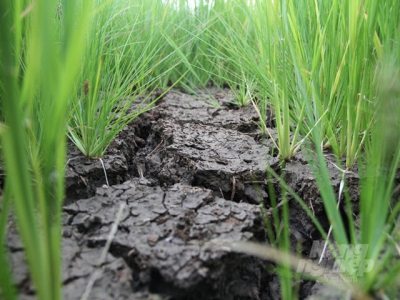Drought threatens thousands of hectares of crops

There have been 18,794 hectares of crop affected by drought and water shortage in the Central Highlands, of which Gia Lai province suffered the most.
Low capacity of irrigation reservoirs
According to a report of the General Department of Irrigation under the Ministry of Agriculture and Rural Development, the average capacity of irrigation reservoirs in the northern region is 63.6% of the designed capacity (DC).
In the central region, the capacity of irrigation reservoirs has begun to decrease. Specifically, in the North Central region, the average irrigation reservoir capacity has reached 40.5%, down 2.5% compared to last week, of which Thanh Hoa is 40%, Nghe An 43%, Ha Tinh 51 %, Quang Binh 40%, Quang Tri 20%, Thua Thien Hue 18%. Existing hydropower reservoirs have capacities ranging from 20 to 63% of the DC.
The average volume of irrigation reservoirs in the south central region has reached 25% of the DC, down 2% compared to last week. In particular, Da Nang is 28%, Quang Nam 22%, Quang Ngai 17%, Binh Dinh 18%, Phu Yen 23%, Khanh Hoa 38%, and Ninh Thuan 26%, Binh Thuan 43%. The total capacity of hydropower reservoirs has decreased by 31 million metres cubed.
In the Central Highlands, the average capacity of irrigation reservoirs has reached 41% of the DC, down 1% compared to the previous week. Specifically, Kon Tum is 44%, Gia Lai 39%, Dak Lak 27%, Dak Nong 67%, and Lam Dong 75%. The total capacity of hydroelectric reservoirs has increased by about 5 million metres cubed.
About 25,000 hectares affected by drought
Due to rain shortages and prolonged heat, a total of 3,301 households in Phu Yen Province lacked domestic water (Tuy An 834 households, Son Hoa 1,450 households, Song Cau town 762 households and Dong Xuan 255 households).
In the northern mountainous region, a total of 1,596 hectares are suffering from drought while another 414 hectares are at risk. Specifically, in Cao Bang Province, the drought-stricken area is approximately 1,596 hectares while in Lang Son Province, as of August 16, 2021, the area at risk of drought is 414.4 hectares and 18 reservoirs are at low water level.
In the North Central region, the whole province of Thua Thien - Hue has had rains in the past week so the drought situation has improved. Currently the province has 55 hectares of rice suffering from drought, down 535 hectares compared to last week. This is concentrated in the mountainous areas of Nam Dong district with 10 hectares, and A Luoi with 45 hectares in the irrigation areas of small dams.
The south central region currently has a total of 1,645 hectares of rice in Phu Yen Province that are affected by drought and water shortage (Son Hoa 87 ha, Tay Hoa 791 ha, Dong Hoa 397 ha, Song Hinh 388 ha).
The total precipitation from Da Nang to Binh Dinh since the beginning of this year is very low compared to the same period in many other years, commonly a 40-60% shortage. Quang Nam and Da Nang in particular are at a higher level, with a 50-70% shortage.
Due to the large shortage of rainfall since the beginning of the year and prolonged heat, it is forecasted that the total area in the whole region likely to be affected by drought, water shortage, and saltwater intrusion in August 2021 is from 2,100 to 2,500 hectares (Phu Yen 1,800 - 2,000 ha, Quang Ngai 100 to 200 ha, Binh Dinh 200 to 300 ha).
In the Central Highlands, there are currently 18,794 hectares affected by drought and water shortage, mainly in areas outside irrigation works. Specifically, Gia Lai Province has18,083 ha (KBang district 1,811 ha; Mang Yang 15 ha and Krong Pa 16,257 ha), and Dak Lak Province 711 ha (M'Drak district).
Nguyen Van Tinh, Director of the General Department of Irrigation predicted that the affected area in Gia Lai Province may increase to about 18,000 ha and the affected area in Dak Lak Province may increase by 5,000 to 7,000 ha (concentrated in M'Drak, Ea Kar, Krong Pak, Krong Bong, Krong Nang districts) by the end of this month if the rainfall still remains low.
Có thể bạn quan tâm
 Farmers encouraged to plant autumn-winter crops in dyke-protected regions
Farmers encouraged to plant autumn-winter crops in dyke-protected regions Farmers in An Giang are advised to plant inside 699 protected dyke subregions to ensure that the sown area has 100% flood control embankments.
 Summer-autumn rice consumption in Mekong Delta provinces facing lot of difficulties
Summer-autumn rice consumption in Mekong Delta provinces facing lot of difficulties The harvesting, trade and transportation of summer-autumn rice crops continue facing many difficulties, possibly causing negative impacts to following seasons.
 Changing mindset in tea growing thanks to IPM
Changing mindset in tea growing thanks to IPM In the first 2 decades of the 21st century, among the 4 tea schemes implemented, Thai Nguyen had had 3 schemes focusing on the application of IPM.